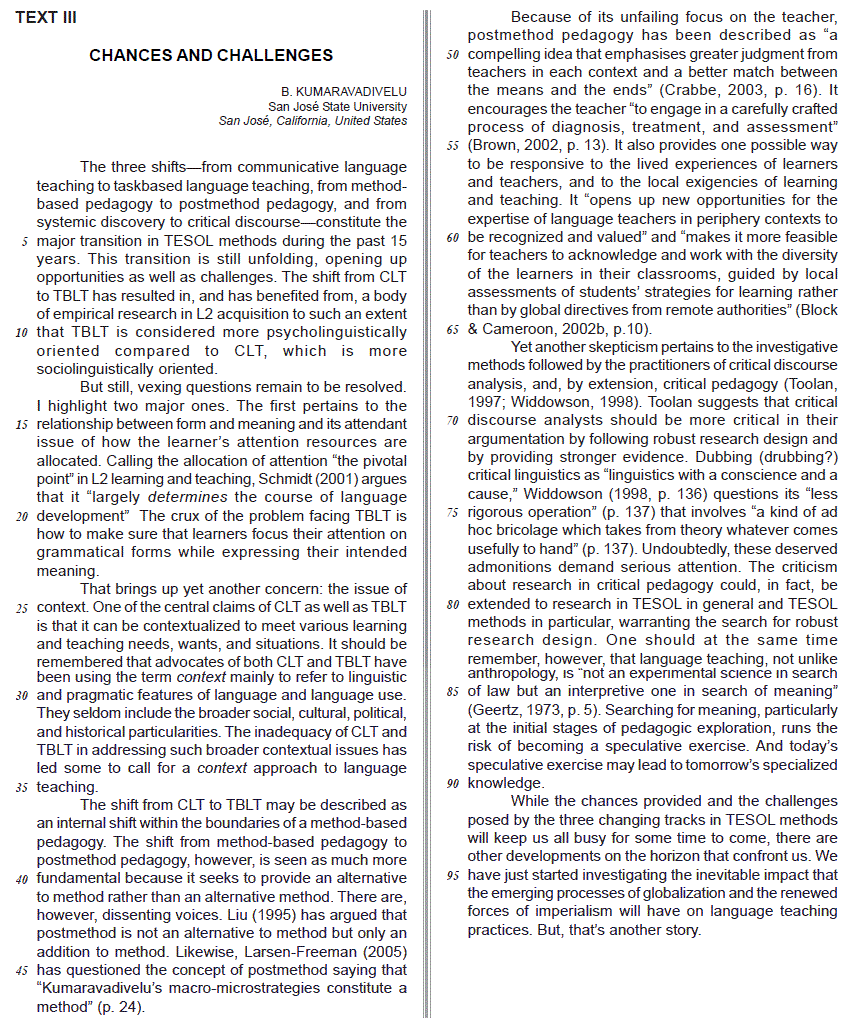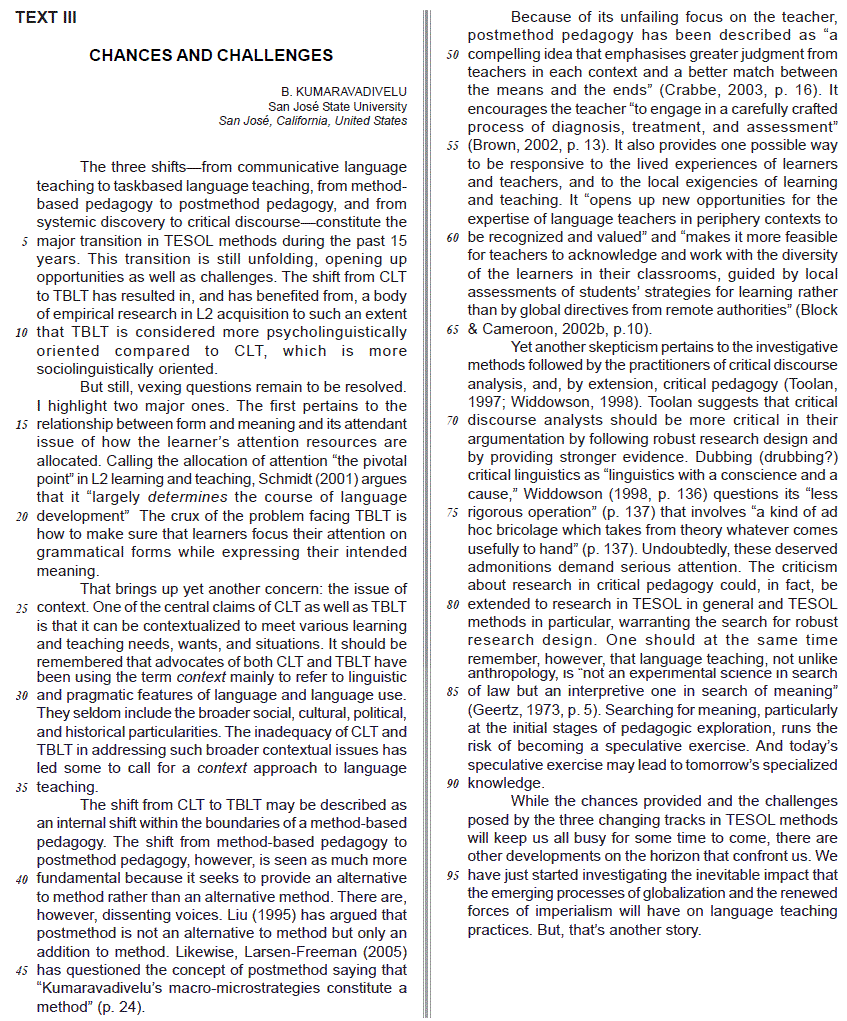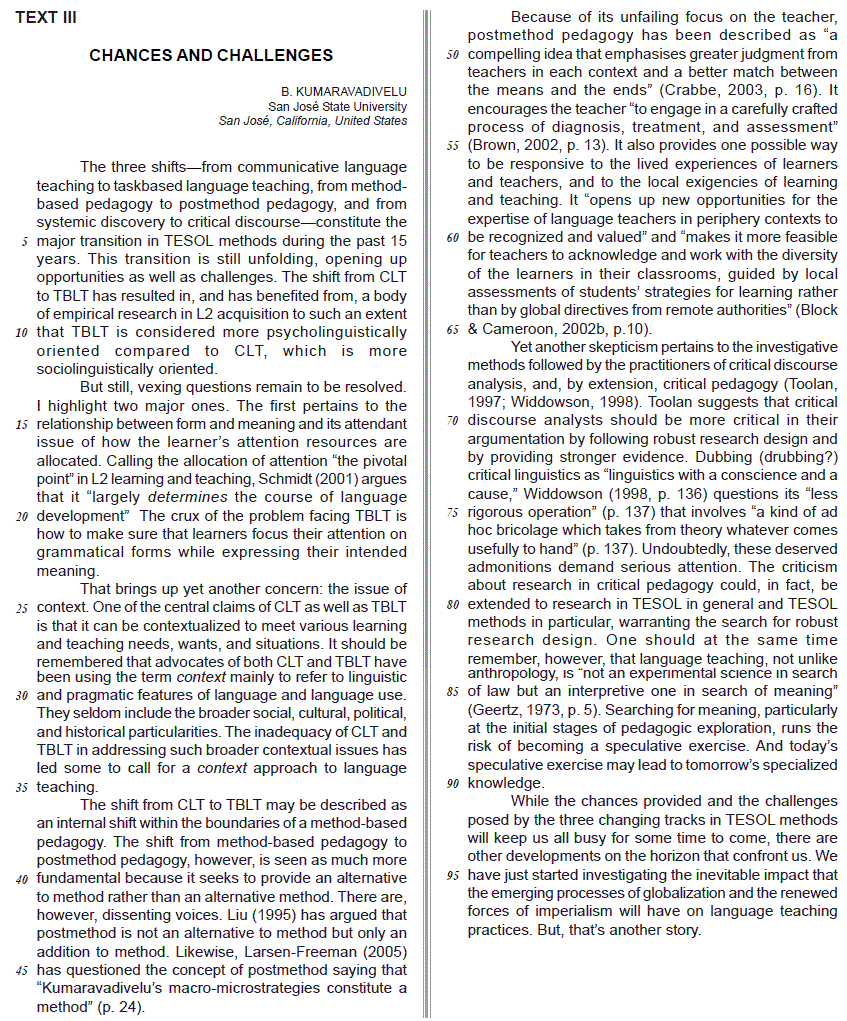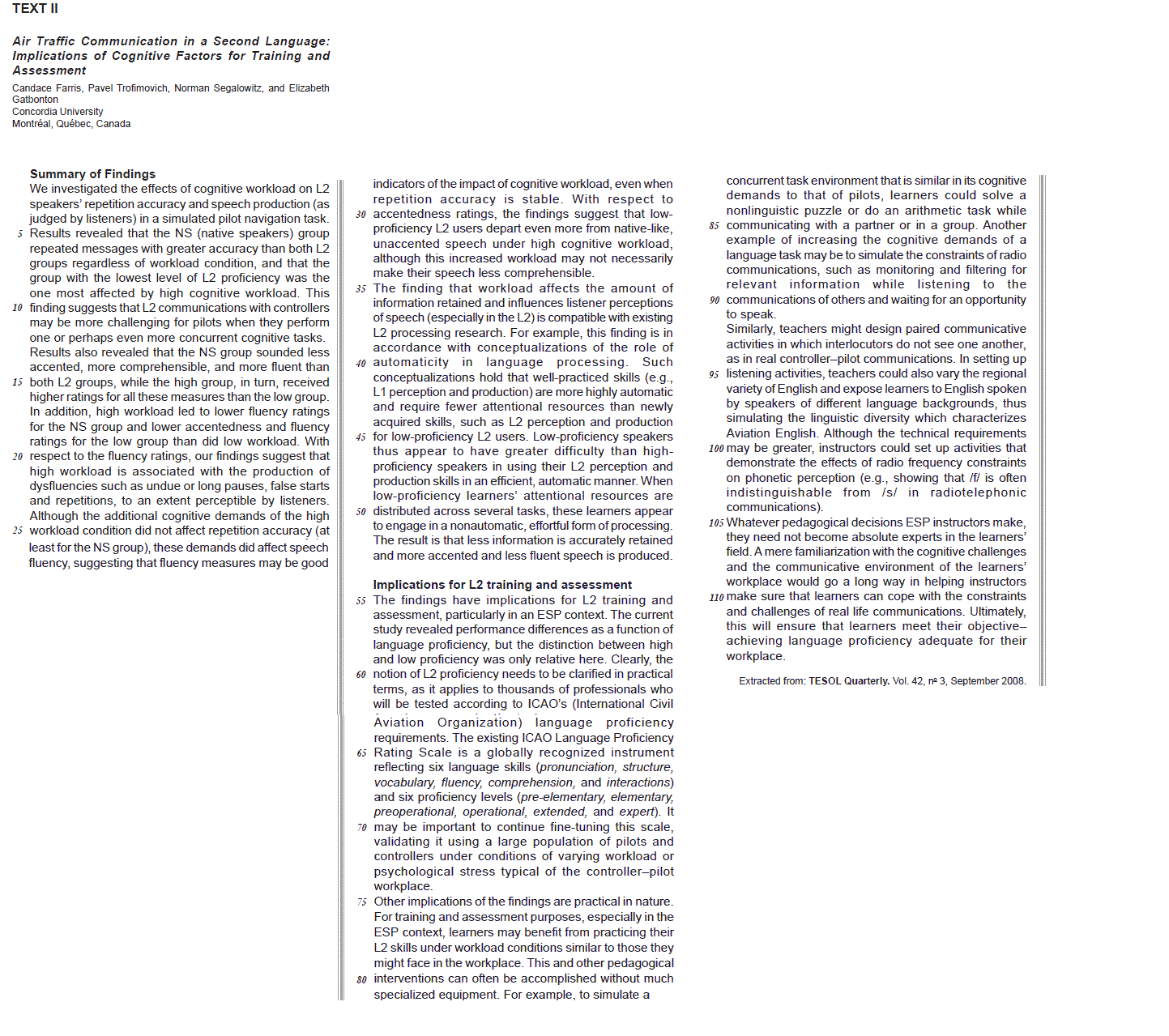Questões de Língua Inglesa da Fundação CESGRANRIO (CESGRANRIO)
Lista completa de Questões de Língua Inglesa da Fundação CESGRANRIO (CESGRANRIO) para resolução totalmente grátis. Selecione os assuntos no filtro de questões e comece a resolver exercícios.
There is no link between performance dissimilarities and language proficiency in the communication between pilots and air traffic controllers.
- A.
While the high L2 group sounded less accented, more comprehensible and more fluent than the low L2 group, the NS group performed better than both L2 groups in these measures.
- B.
Undue or long pauses, repetitions and false starts are dysfluencies imperceptible by listeners.
- C.
Since the NS group members had their fluency affected by additional cognitive demands of high workload conditions, fluency measures may be a good indicator of cognitive overload.
- D.
Both the amount of retained information and the listeners perception of speech are affected by the workload.
- E. High cognitive workload worsens the speech production of low-proficiency L2 speakers.

The communicative intention of Text 3 is to
- A.
describe the past challenges in TESOL Methods from a historical perspective.
- B.
criticize the interpretation of the three major shifts in TESOL Methods as challenging trends.
- C.
comment on the three major shifts in TESOL Methods and their influences on current challenging trends.
- D.
blame the three major shifts in TESOL Methods for all the current problems in language teaching.
- E.
endorse the inappropriateness of the three major shifts in TESOL Methods as guidelines for current challenging trends.

This passage is most likely part of
- A.
a historical survey of trends in the EFL scenario.
- B.
a journal entry of an in-service teacher diary in her first teaching experience.
- C.
a state-of-the-art essay taking stock on recent developments in TEFL.
- D.
a textbook on language teaching methodologies for pre-service teachers.
- E.
an essay on how to overcome the fear of teaching.

Schmidt (2001) argues that it largely determines the course of language development (lines 18-20) It should be remembered that advocates of both CLT and TBLT have been using the term context mainly to refer to linguistic and pragmatic features of language and language use. (lines 27-30)
Which of the alternatives below correctly explains the use of italics in the two fragments above?
- A.
The author intended to emphasize the words determines and context as they had been mentioned previously.
- B.
The author italicized the word determines to stress the idea of causation; the italics in context substitutes for quotation marks.
- C.
The words determines and context were italicized for emphasis since they represent ideas exposed by others, not the author himself.
- D.
The italics in the term context refers to a newly-coined term in LT methodology; the word determines in italics reveals that Schmidt was too authoritative in choosing this term.
- E.
Both words (determines and context) are terms employed by others and explained by the author of this text.

In The shift from method-based pedagogy to postmethod pedagogy, however, is seen as much more fundamental because it seeks to provide an alternative to method rather than an alternative method. (lines 38-41), the author implies that
- A.
alternative forms of learning are, ideally, not appropriate categories of method-based pedagogy.
- B.
TBLT can be said to be a shift toward alternative means of second/foreign language pedagogy.
- C.
all methods that emerged before were just alternative ways to teach fundamentals of the language.
- D.
the emergence of a postmethod paradigm is merely the consequence of expanding the boundaries of CLT.
- E.
the current teaching trend advocates for creative forms of learning that do not necessarily constitute a strict method.
The fragment It encourages the teacher to engage in a carefully crafted process of diagnosis, treatment, and assessment (Brown, 2002, p. 13). It also provides one possible way to be responsive to the lived experiences of learners and teachers, and to the local exigencies of learning and teaching. (lines 52-58) refers to pillars of postmethod pedagogy.
Which of the principles mentioned in this fragment are also representative of the core values of English for Academic Reading?
- A.
Diagram of learners needs and responding to the future experiences of teachers.
- B.
Sensitivity to the local exigencies of learning modes and strategies and treatment of learners.
- C.
Diagnosis of learners needs, assessment of learners outcomes and attention to the experiences of learners and teachers in the field.
- D.
Diagnosis and treatment of learners problems in the classroom environment with special regard to their overall health condition.
- E.
Localizing teachers and learners exigencies in experimenting with diagnosis, treatment and assessment of how they respond to their problems in life.
The author ends his text with the cliché But thats another story, because
- A.
we will be kept busy uncovering the stories that underlie the recent developments in TESOL methods.
- B.
the challenges of the three recent paradigms in ESL/ EFL methods will impose other personal stories of learning processes.
- C.
the situation of Language Teaching practices in imperialistic countries is quite different from the context he has analyzed in this article.
- D.
he has run out of space to comment further on the three changing tracks in TESOL methods and how they will impact globalization.
- E.
he does not really intend, in this article, to discuss the consequences of globalization and world Englishes on language teaching methodologies.
All of the sentences below, rephrasing ideas contained in the passage, contain mistakes in language use, from the point of view of standard written English, EXCEPT FOR:
- A.
Having started investigations, the emerging process of globalization is still not known.
- B.
Each of the advocates of CLT and TBLT can submit their ideas on contextualization.
- C.
Neither the postmethod-generation TESOLer nor the strong supporter of TBLT are aware of what determines the course of language teaching development.
- D.
The founding-father of critical pedagogy, together with critical discourse analysts, have been accused of being lenient in analyzing recent methodological trends.
- E. One reason for the skepticism towards critical pedagogy may have lain in the unwillingness of researchers to be more precise in their argumentation and research design.
The author comments that the TBLT approach is an offshoot of CLT. In another section of his full article, he comments that CLT was a principled response to the perceived failure of [previous methods]. Read the following claims on ELT methodology/approaches.
I - The Audiolingual methods proclaimed goal of fostering communicative capability in the learner was based on the presentation-practice-production sequence.
II - CLT emphasizes language competence in terms of social interaction, considering the main linguistic principles of speech act theory, functional grammar, communicative competence, introduced by Austin, Halliday and Dell Hymes, respectively.
III - CLT was a theoretically based approach that reinforced the emphasis on the linguistic structures of the target language, as supported by the Audiolingual method.
IV - The Audiolingual method conveyed a largely structural orientation that relied on a rendering of pattern practices with pseudo-meaningful exchanges of scripted dialogues.
V - The Grammar-Translation method was grounded on the principles of American structuralist linguistics and behaviorist psychology in language teaching methods and materials.
Mark the alternative that contains only correct claims.
- A.
I, II and IV.
- B.
I, III and IV.
- C.
II, III and V.
- D.
I, II, III and V.
- E.
II, III, IV and V.

The words undue (line 22) and unaccented (line 32) are formed by the prefix un. In which of the words below would it be possible to add the same prefix to express an opposing idea in Standard English?
- A.
Stable
- B.
Different
- C.
Cognitive
- D.
Adequate
- E.
Compatible


